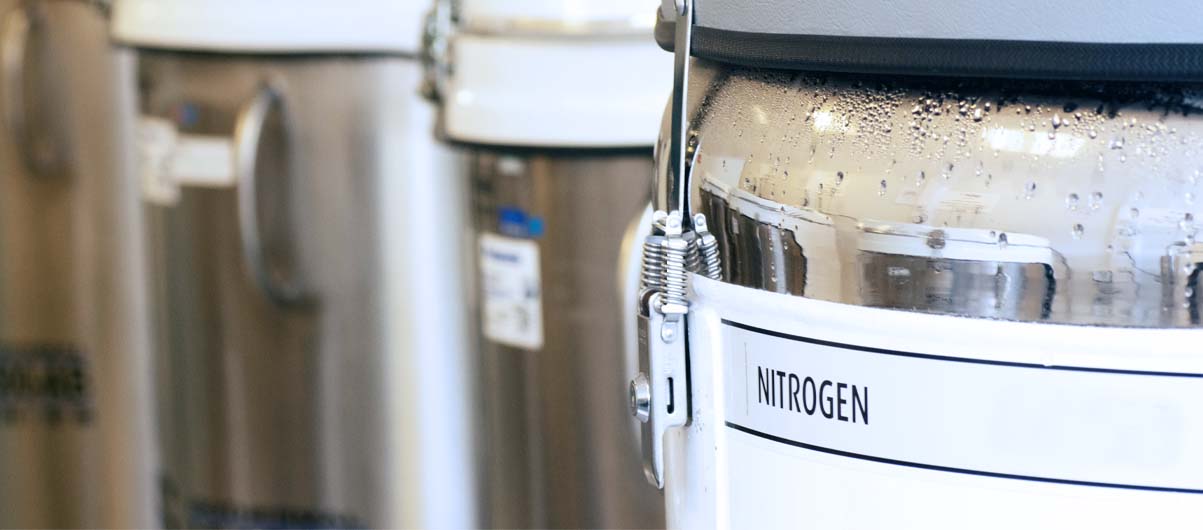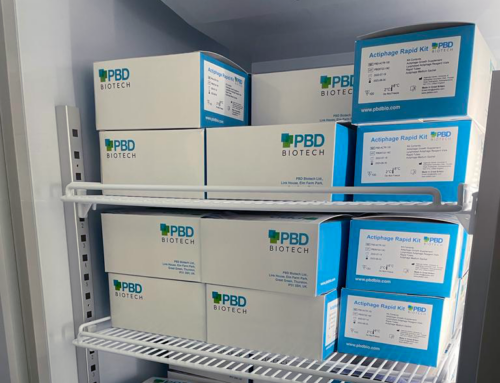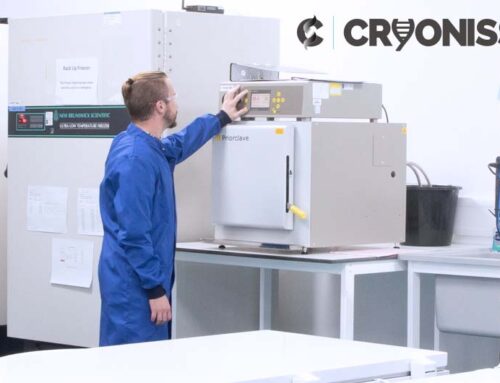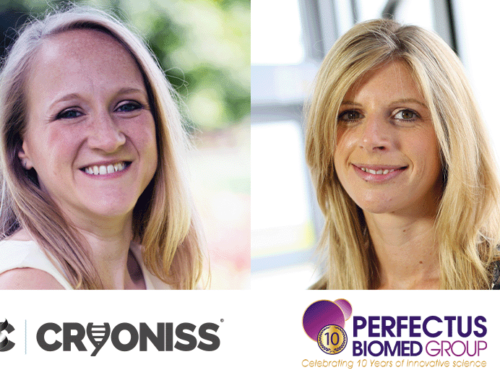Liquid Nitrogen – A Day in the Life of a LN2 Facility Manager
When it comes to a Liquid Nitrogen facility, the human factor is key.
*Warning… Some readers may find concepts here disturbing.
So, I have just left a marketing team meeting and this month’s newsletter content is looking excellent. We have a second author in our midst, Amanda Capes-Davis, who has just published a fantastic textbook for cell culture biologists: the first author I should note is Kathryn Simpson, who has published a great insight into leading change.
To give our readership a glimpse behind the scenes of our operations, the team have asked me to write about how we manage a liquid nitrogen facility. I must emphasise at this point that there are some disturbing concepts mentioned below; however, these are important examples of the risks that we manage and train our team to work with on a daily basis, and ultimately, protect our customers from.
Our liquid nitrogen training days
As many of you will be aware, Phil and I used to run AstraZeneca’s mammalian cell line repository, a world class vapour phase liquid nitrogen (LN2) facility, holding 900 L of liquid nitrogen in a contained room, with irreplaceable samples that degrade if thawed. Not only is liquid nitrogen gas an asphyxiant, but it also has an expansion ratio of 683:1, so 1L of liquid nitrogen will evaporate and expand into 683L of asphyxiant gas.
Never have there been two conflicting safety requirements to balance with so much at stake on either side, namely human life versus business impact. I can truly say that the on-site Safety, Health and Environment team, Engineering and Security teams are without doubt critical in ensuring that these two factors are managed well to protect staff AND samples.
Building and maintaining the facility
Having managed, designed and implemented similar facilities over the past 10 years, Phil and I have become quite adept at this. There are countless aspects to consider initially before designing and building a new LN2 facility. Firstly, we always employ a single, experienced contractor to support the holistic installation of the entire facility. The last thing you need is to be querying which contractor owns which valve in the case of an issue.
Then there are the technical issues: Are you going to have a wet line, or a dry line that you prime before use each time? What are your potential losses of gas from super insulated vacuumed lines, and the security and access to the bulk tank? How are you going to set up your tanks in the room, considering risks of liquid nitrogen entering the room from a pin-hole fracture in the SIVL for example? Do your staff have multiple exit strategies? Have you completed air flow analysis to look at potential areas in the room where nitrogen gas can create pockets and potential risk to staff? Is the air handling balanced? Where do you place your oxygen monitors, and do you have a safety implemented system to ensure that your staff are certain it is safe to enter and remain in the facility?
The engineering infrastructure is a balance between critically keeping people alive on one hand and ensuring your safety procedures do not unexpectedly place your samples at risk, particularly when engineering work is ongoing, on the other. For this, Cryoniss have a plethora of procedures and risk assessments that are part of our business continuity management system. It really is just another day at the office.
People are the most important aspect
Aside from the all-important engineering aspect, there is a heavy focus on human factors. I am a great believer that any organisation is only as good as its people. And when it comes to a LN2 facility, this is even more critical than ever. Only this year in January 2021, 6 people in Georgia tragically died due to a burst LN2 pipe in a controlled facility. The devastating truth is that most incidents that occur in facilities such as ours lead to multiple fatalities.
Liquid nitrogen gas is a clear, tasteless, odourless gas, with low reactive tendencies. For those interested in the reactivity of nitrogen versus the true noble gases, I shall forward you to more in-depth chemistry discussions here. Whilst nitrogen makes up 78% of our atmosphere, in a concentrated state such as that used in our facility, a couple of breaths can lead to mental and physical impairment and eventual death, as the nitrogen displaces the oxygen in our lungs. Remember that breathing is primarily driven by carotid body chemoreceptors in the brainstem that sense increased hydrogen ions in the blood from carbon dioxide.
As a result, a depletion in oxygen in the body due to displacement with nitrogen does not necessarily lead to an immediate increase in respiration rate. Frequently, impaired thinking can be one of the earlier symptoms, which places people in even greater risk. So subtle is the decline of the person, that several US states considered using it as a method for the death penalty.
| Atmospheric oxygen concentration (%) | Possible symptoms |
|
20.9 |
Normal |
|
19.0 |
Some unnoticeable adverse physiological effects |
|
16.0 |
Increased pulse and breathing rate, impaired thinking and attention, reduced coordination |
|
14.0 |
Abnormal fatigue upon exertion, emotional upset, faulty coordination, poor judgement |
|
12.5 |
Very poor judgement and coordination, impaired respiration that may cause permanent heart damage, nausea and vomiting |
|
<10 |
Inability to move, loss of consciousness, convulsions, death. |
Anyone who works in a facility like this knows that in the event of a colleague collapsing in the facility, you must immediately call the emergency response team to attend site with their breathing apparatus and secure the area – this is the significance of the all-important buddy system. Any person in the world would struggle to resist the natural response to help a stricken colleague, and this is why we train our staff extensively in managing your own humanity and to follow emergency procedures. It is certainly a difficult training session to give to new recruits, but to date I have never had anyone not turn up for their second day at work. I must be doing something right?
Mental Health
Working in such a dangerous facility as this, where one inhalation of the vapour phase nitrogen can lead to death, supporting colleague’s mental health is a critical consideration. To support our team, especially during such a stressful time as a global pandemic, Cryoniss has partnered with Able Futures who provide training and support to employers, but also a helping hand to individuals. For anyone struggling at this time, Able Futures are there to listen. Contact them directly at 0800 321 3137.
Emergency training procedures
So, you have built the facility to ensure your staff have alerts and visual and audible checks to confirm it is safe to work in. The samples are safe in the tanks and filling procedures are in place, with telemetric systems to top up the bulk tank automatically. Fully trained staff have a healthy respect of entering the facility and a no-blame culture is in place. Full PPE is ready, and everyone is empowered to challenge each other on their safety practices in the facility, no matter what their grade.
Next, what are your emergency procedures? So many labs have liquid nitrogen dewars in the corner on the LN2 proof mat, however not many people are aware of what to do if they get liquid nitrogen burn.
First and foremost, do not take clothing off the affected area of skin! Submerge into tepid water whilst awaiting the arrival of first aid responders. At -196°C, a simple spill can essentially lead to frostbite. When the risks are so high, the consequences so dramatic and the emergency procedures so complex, it makes sense to let the experts take that headache away.
We provide sample integrity assurance
Providing assurance of sample integrity to our customers is the core of Cryoniss’ business, and every aspect of our end-to-end logistics service and sample handling is optimised to minimise any fluctuations in temperature of the samples. From employing liquid nitrogen adsorbed dryshippers to the use of CryoPods in the lab, the samples are always kept at <-170 °C. Phil has even optimised the racking in our tanks to enable a single vial to be picked carefully and correctly, from opening the tank to closing the tank, in under a minute, all whilst protecting the rest of the samples in the tower.
To achieve this level of speed, sample safety coupled with accuracy of sample-picking requires each sample location to be correct to vial-level location, tracked on a laboratory inventory management system (LIMS). We have a highly flexible, cloud-based, fully auditable LIMS system, which is Good Laboratory Practice compliant and supports our ability to offer tailored solutions to our customers.
Summary
I have provided here just a glimpse into the world that is cryogenic facility management without even touching upon BoSHE’s, HAZOPs, LOPA’s, SIS, SHE, training manuals, competency sign offs, employee contracts, planned preventative maintenance and emergency response service agreements, calibrations, audits and 24/7/365 call outs and the all-important business continuity management system etc. However, were I to cover all of this in depth, this blog would turn into a 3-inch manual.
Designing a liquid nitrogen facility requires significant experience from both an engineering and safety perspective. Ultimately however, maintaining it to the highest standards, coupled with providing exceptional sample management and customer service requires a truly empowered and passionate team, one which ultimately is driven by the company’s culture.
At Cryoniss, every level of our organisation is driven to ensure we maintain the highest standards of service and safety, and to support our staff to continue to excel at providing a world class service to our customers.
Contact us today to see how we can support you with your sample storage and logistics needs, or support with running your liquid nitrogen facility.







